

Chaerocampa [sic] silhetensis Walker, 1856, List Specimens lepid. Insects Colln Br. Mus. 8: 143. Type locality: Ceylon [Sri Lanka]; North India; [Bangladesh,] Silhet [Sylhet]; Nepaul [Nepal]; North China.
Synonym. Theretra pinastrina sensu auct., nec Martyn, 1797.
Synonym. Chaerocampa silhetensis Walker, 1856.
[Further details on this species in Japan, as well as photos of many stages, can be found on Digital Moths of Japan as well as Moths of the southern Shikoku, Japan.]
Wingspan: 60--72mm. Superficially similar to Theretra oldenlandiae oldenlandiae, but paler and immediately distinguishable by the single white dorsal abdominal line. Forewing upperside similar to Theretra oldenlandiae oldenlandiae; fourth postmedian line distinct, space between third and fourth postmedian lines silvery whereas that between fourth and fifth postmedian lines is beige and broader, fifth postmedian line thicker than sixth.
In the male genitalia, uncus less curved than in Theretra margarita, more strongly compressed apically. Gnathos ribbed along edges dorsally as in Theretra margarita, apical margin notched, less distinctly bisinuate. Phallus with processes narrower and longer than in Theretra margarita.
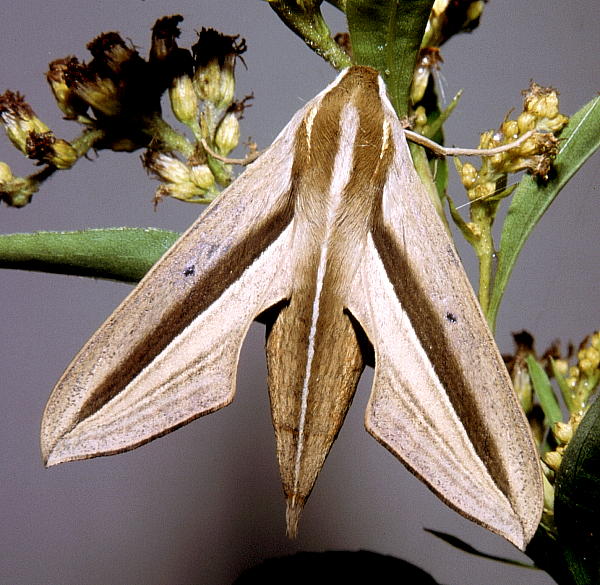
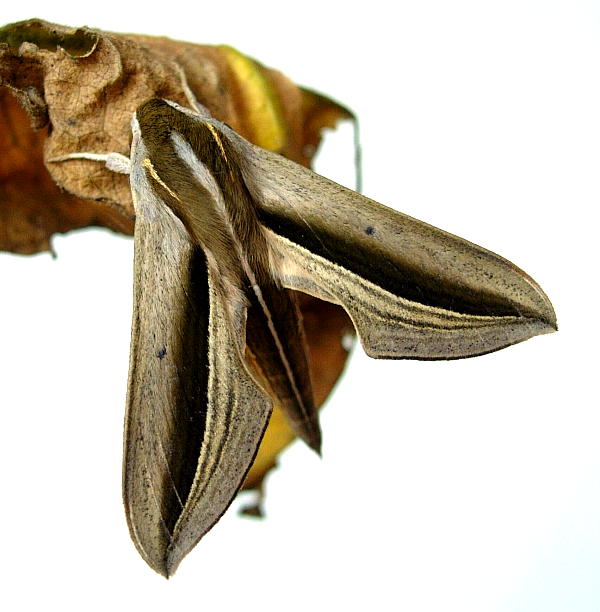

This species will not mate nor oviposit at temperatures below 15°C (Yeh, 1985).
China: iii-x (Hong Kong); iv-vii (Guangdong); vi (Jiangsu; Shanghai; Hubei); viii (Fujian); ix (Shanghai). Taiwan: iii-vi (Nantou Hsien); vi (Tainan); vii (Tainan Hsien); ix (Taipei). Japan: iii (Ryukyu Archipelago); 6.vi-5.x (Ryukyu Archipelago); 20.vi-5.viii (Kyushu); 17.viii (Shikoku).
OVUM: Pale bluish-green at first, then becoming grass-green; almost spherical (1.4 x 1.3 x 1.3mm), shiny and smooth (Bell & Scott, 1937). Laid singly on both the upper and lower side of leaves. Hatches after 8.4-10.4 days at 20°C, and after 3.2-4.4 days at 26°C (Yeh, 1985).
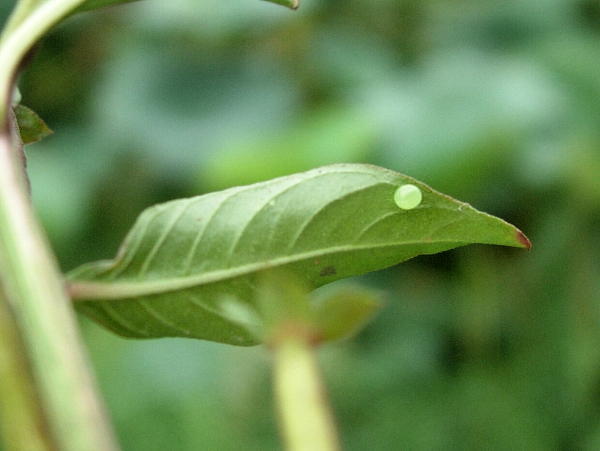
LARVA: Full-fed 55--80mm, breadth 10mm, horn 2mm. Dichromatic: green or brown.
Newly hatched larvae are pale yellow with a small, straight black horn and a khaki-coloured head. With feeding the body becomes pale green. In the second instar, head and body pale yellowish-green with an indistinct dark dorsal stripe. There are dark-coloured ocelli on segments 5 to 11, and the horn is short and of a pale rose-colour. By the third instar the head has become a darker green. The body is now green dotted with yellow; the dorsal stripe is violet; the ocelli black; but the horn is still short and pink in colour. In the fourth instar the head becomes pale pinkish-brown speckled with darker dots; the body is pale pinkish-brown dotted with yellow, and there is a narrow, dark, dorsal stripe on segment 2; there is also a slightly fuscous dorso-lateral stripe. The ocellus on 5 is small, round, the pupil greyish-blue touched with pale orange below, edged narrowly with first white and then black. There is a larger, longitudinally oval, similarly coloured ocellus on 6, with the oval flattened below. There is then a slightly larger ocellus on each of segments 7 to 10, smaller on 11, with the pale orange rather more extended but the colour otherwise the same. Horn short, coloured like the body (Bell & Scott, 1937).
In the final instar the head is smooth and dull, the true clypeus nearly equilaterally triangular, less than one-half length of head. False clypeus with rounded apex reaching to one-half length of head; labrum about three-quarters as long as clypeus; ligula as long as labrum, slightly narrower, rounded kidney-shaped; cutting-edge of mandible with small triangular teeth. The body is also smooth and dull, rather elongate, with segments 4 and 5 not much swollen. The horn is smooth and shiny, very short, thick at base and tapering sharply to a point. The horn rises from a fleshy cone, of which it forms a regular continuation.
There are two main colour forms -- green and brown. In the green form the head is green with a bluish tinge, obscurely dotted with groups of dark-coloured dots. Labrum and ligula greenish; basal segment of antenna green, second segment paler, end segment rusty; mandible green, tip shortly reddish-brown; eyes 1 and 5 green with black pupils, 3, 4 and 6 rusty, 2 whitish. Body grass-green with a number of short, yellow stripes across the secondary rings in the dorsal and lateral area, and yellow dots below the spiracular line. There is a narrow bluish dorsal stripe and a narrow obscure yellowish dorso-lateral stripe from 2 to base of the horn, broken by ocelli; a similar subspiracular stripe runs from segments 5 to 12. There is a small, inconspicuous dorso-lateral ocellus on 5, which is green edged with yellow; a similar, slightly larger ocellus on 6, edged narrowly above with black; and a similar, still larger ocellus on each of 7 to 10. On segment 11 the ocellus is as large as that on 5, but edged with black above. In all the oval ocelli the dorsad curve is more convex than the ventral; the pupils sometimes bluish instead of green. Horn yellow, tip orange. Spiracles oval, white with a broad purple band across the middle; the ends only short white, the whole with a narrow, yellowish, shiny rim.
In the brown form the green is replaced by a pinkish-chocolate colour, which may be tinged with red or plum. There are two parallel pale dorsal stripes, the area between these and the dorso-lateral ocelli darker. The oval ocelli are centred dark chocolate with a pale yellow crescent above and an orange one below, the entire 'eye' encircled by a narrow black ring. Subspiraclular stripe 2mm wide and pale chocolate, the area between this and the ocelli of the same intermediate colour as the dorsal stripes; the head is of the same colour. Ventral surface dark chocolate; true legs pale pinkish-chocolate; claspers dark chocolate. The colours are not solid but macular.
A very inactive species which moves as little as possible. Younger larvae rest stretched out along small stems among leaves when not feeding. In the final instar most, which are now various shades of brown, rest along the darker main stem low down on the plant, often just above the water level if the hostplant is gowing in water. If on the underside of Caladium leaves hanging over water, then most rest stretched out along the midrib.
This stage lasts 25-29 days at 20°C, and 20-23 days at 26°C (Yeh, 1985). At 30°C this drops to 13-15 days (Yeh, 1985).
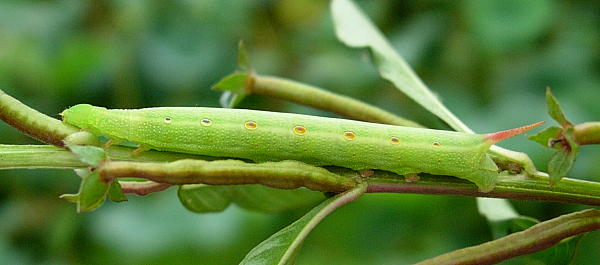



PUPA: 43--47mm. Colour pinkish bone-colour; sides of tongue-sheath, head and fore leg dotted with black; wing-case fuscous-grey, the clearly marked veins edged narrowly with a soiled yellow. There is a very narrow brownish-green dorsal stripe from 2 to 13 and a broad brown dorso-lateral stripe. There is also a narrower spiracular stripe of the same colour, and the abdomen has a broad dark ventral stripe and a narrow, obscure latero-ventral stripe. The whole pupa is marked with short, obscure, dark streaks; the raised spiracles are black; the cremaster dark reddish-brown.
Somewhat elongate and cylindrical. The tongue-case not projecting much frontad. Antenna slightly shorter than fore leg, which reaches to one-third the distance to the tip of wing-case, mid-leg to two-thirds that distance. There is a long, narrow coxal piece. Surface slightly shiny. Edge of tongue-case shiny and mesially channelled. Head, thorax and sides of tongue-case coarsely but superficially wrinkled. Wing-case with the veins broadly prominent, the surface more minutely wrinkled. Segment 3 with some pits behind the spiracle of 2; abdomen very finely transversely wrinkled and shallowly pitted; hind bevels of 8 to 10 smooth, front bevels of 9 to 11 minutely pitted. Spiracle of 2 a narrow slit lying between the slightly raised, shallowly emarginate hind margin of 2 and a narrow, transverse, oblong lobe, its front edge raised, hind edge depressed, projecting from the front margin of 3; remaining spiracles oval, the surface rising gently to the central slit, which has a narrow, shiny rim. Cremaster triangular, sharply pointed, downward curving, tip seen under a lens to be minutely bifid; ventral surface keeled, with a channel on each side of the keel (Bell & Scott, 1937).
A rather inactive species which moves very little, even if disturbed.
Lasts 20-22 days at 20°C, and 15-16.4 days at 26°C (Yeh, 1985). At 30°C this drops to 9-10.4 days (Yeh, 1985).
Present on Taiwan from February until late November (Yeh, 1985).


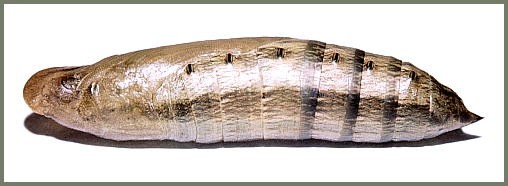


Larval hostplants. The cultivated Colocasia antiquorum in southern China (Mell, 1935). In August 2004 numerous eggs and larvae were found on Ludwigia along a lake at Hangzhou, Zhejiang (Pittaway, pers. obs. 2004). These same plants were also being utilized by Theretra japonica.
Recorded on Taiwan from Alocasia odora, Colocasia esculenta [syn. Colocasia formosana], Colocasia gigantea, Colocasia antiquorum [syn. Colocasia tonoimo], Impatiens walleriana, Ludwigia adscendens, Ludwigia hyssopifolia and Ludwigia octovalvis.
Recorded in Japan from Colocasia esculenta (Nozakai & Miyata, 1989).
In India on Ludwigia repens and Boerhavia (Bell and Scott, 1937). Numerous other hostplants are recorded from elsewhere, most notably species of Arum, Caladium, Pistia, Kochia, Ipomoea, Boerhavia, Ludwigia, Rosa and Trapa.
[Easily reared in captivity on various species of Epilobium, even E. hirsutum, but best started on smoother-leaved species.]

Ichneumonidae: Pimpla luctuosa Smith, 1874; Braconidae: Macrostomion sumatranum (Enderlein, 1920). Tachinidae: Senometopia prima Baranov, 1931.
Adults of Macrostomion sumatranum were recorded as emerging from a mummified larva found on Okinawa, Japan (Maeto & Arakaki, 2005).

China: Jiangsu (Longtan); Zhejiang (Hangzhou); Hubei (Mt. Guifeng, Macheng; Wuhan); Sichuan (Emei Shan; Baoshan); Yunnan; Guizhou (Xinzhaidashan, Zhijin County, 1000-2000m); Hunan (Wuliyuan); Jiangxi; Fujian (Guangze, 1200m; Longqi Shan); Guangdong (Luofu Shan; E. Nan Ling; Xiaolan; Wanzishan, Deqing; ??Wa-Sha-Tai; Zhaoqing); Macau; Hong Kong (Sau Kei Wan; Kowloon; Lam Tsuen Valley, Tai Po); Hainan (Longhushan, Wenchang City).
Taiwan: Hualien Hsien (Taroko National Park; Hungyeh; Antung); Tainan; Tainan Hsien (Kuantzuling); Nantou Hsien (Puli); Taipei; Taipei Hsien (Fushan; Wulai); Taiping.
Japan: Honshu (Yamaguchi Pref.); Kyushu (Yoshi; Naze); Shikoku (Matsuyama; Shimanto); Tanegashima; Ryukyu Archipelago (Okinawa; Ishigaki-jima; Iriomote-jima; Yonakuni-jima; Oshima-jima; Yaku-jima).
Sri Lanka and southern India as a disjunct population; thence northern India, Nepal, Bhutan (Irungbam & Irungbam, 2019), Bangladesh, Burma/Myanmar, the Andaman and Nicobar Islands (Singh, Ahmad & Chandra, 2021), Thailand, eastern and southern China, Taiwan, central and southern Japan, Vietnam (Le & Vu, 2024), Malaysia (Peninsular, Sarawak), Indonesia (Sumatra, Java, Kalimantan).
Subsp. intersecta (Butler, 1875) occurs from the Philippines south through eastern Indonesia to the Solomon Islands, eastern Australia, and north to Guam (Swezry, 1942).
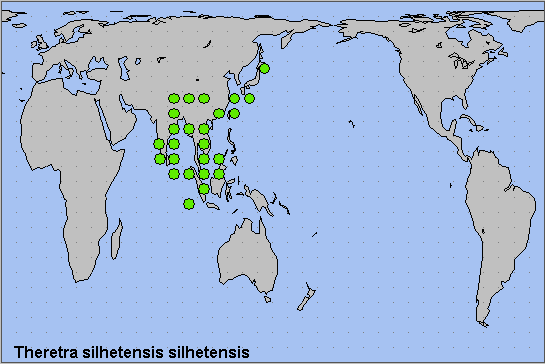
 Return to Sphingidae of the Eastern Palaearctic species list
Return to Sphingidae of the Eastern Palaearctic species list